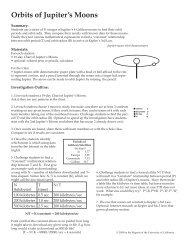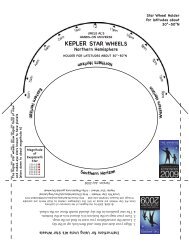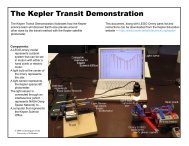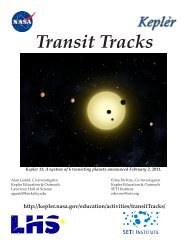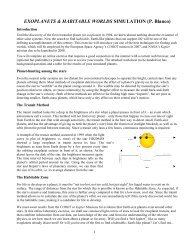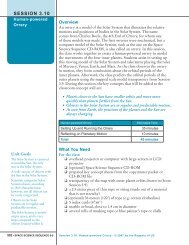Poster Abstracts - Kepler - NASA
Poster Abstracts - Kepler - NASA
Poster Abstracts - Kepler - NASA
- No tags were found...
You also want an ePaper? Increase the reach of your titles
YUMPU automatically turns print PDFs into web optimized ePapers that Google loves.
POSTER ABSTRACTSP0112. POSTER SESSION ISTATISTICS OF NEPTUNE-MASS PLANETS AND SUPER-EARTHS IN A QUIESCENT-DISK PLANET FORMATIONMODEL. P. R. Estrada, I. Mosqueira, Carl Sagan Center, SETI Institute, Mountain View CA 94043, USA, (Paul.R.Estrada@nasa.gov).can be expressed in terms of the Toomre parameter Q asM/M 1 > min[5.2Q −5/7 , 3.8(Q/h) −5/13 ], (1)Figure 1: Plot of the final mass for an inviscid disk of thegap-opening masses. We show three different values for thegas surface density powerlaw exponent to cover a reasonablerange of potential initial conditions. The solid red curve correspondsto the standard model value n =3/2. Kinks seen aredue to transition from the disk back reaction being importantto not important.Introduction: In a weakly turbulent disk the Type I inwardmigration of objects of ∼ 10 M ⊕ stalls due to the feedbackeffect [1,2]. Since in the core-accretion model of planet formationsuch objects can form in a time (10 5 −10 6 yrs) comparableto their migration time, provided that the nebula was enhancedin solids with respect to solar abundances, gap-opening canexplain planet survival. The required enhancement in solids inthe planet-forming region can result from the gas-drag migrationof planetesimals during the early evolution of the extendedsolar nebula. Once such a core forms gap-opening occurs bothdue to rapid gas accretion and because of the tidal interactionwith the gas disk. The final mass of an isolated planet then dependson a competition between these two processes; however,multiple giant planets complicate this picture as one planet canreplenish the feeding zone of its neighbor. Here we investigateplanetary properties using simple parameterized modelsfor the gas accretion rate onto the core and the evolution of thegaseous disk [3] and the results from N-body accretion simulations(e.g., [4]). We will discuss whether this framework ofplanet formation yields planetary masses that are generally inagreement with recent observational constraints [5].Methodology: The non-linear evolution of sound wavesas they travel away from the planet leads to the formationof a shock [6]. For a planet mass M, the distance at whichthe wave first begins to deposit its angular momentum (fora constant surface density disk) is given approximately byl sh ≈ ζ(2H/3)(M/M 1) −2/5 , where H is the local disk scaleheight, M 1 is the upper limit of the mass that may not open agap, and ζ =1.4. More generally, the gap-opening conditionson the limiting mass of the perturber for an inviscid disk [1]where h = H/r. In the right limit, the feedback reaction ofthe disk from the density perturbations to the drift velocitycauses the migrating protoplanet to stall, eventually stoppingmigration and begins to open a gap in place [7,8]. The leftlimit corresponds to the case for which the disk back reaction isunimportant and fails to slow a rapidly migrating protoplanetenough for it to stall. Instead, a gap is opened behind theprotoplanet (opposite the direction of migration). In Figure 1we show the final mass of the giant planet with distance froma solar like star using Eq. (1), for a standard “optically thin”minimum mass model [9, solid curve], under the idealizedassumption that the protoplanet can accrete all of the availablegas within its shocking distance. These examples demonstratethat gap-opening, and subsequently final masses can decreasesharply as you approach the star.In order to begin to properly model the physical processesinvolved in gap-opening by a protoplanet, numerical modelsare required. We have developed a code that incorporatesthe growth of the giant planet with the disk evolution.The gas accretion rate of the giant planet is parameterized usingṀgas = M/τKH, where τKH is the Kelvin-Helmholtztimescale [e.g., 10], and by drawing gas from the protoplanet’sfeeding zone. The half-width of this zone is defined by theminimum of the accretion radius (R a = GM/c 2 , where c isthe local sound speed), and 2.5 R Hill .We solve the self-consistent equation for the surface densityevolution by combining the equations of continuity andangular momentum:( »∂Σ∂t = 1– )−1∂ ∂ ∂2πr ∂r ∂r (Ωr2 )∂r (Gν − F ) , (2)where G ν and F are the viscous and gas tidal torque, respectively.For the tidal torque F , we employ two methods. Thefirst is the damping prescription of [6] where the disk is verticallyisothermal and the disk response is strictly 2D[1,3,6].However, the prescription of [6] only takes into account thecontribution of the torque from resonances that lie within a(linear) “launch zone”. These authors calculate the form ofthe wake in the linear zone which they allow to damp in thenon-linear region (beyond ∼ (4/3)H from the protoplanet).Although this accounts for bulk of the torque, we supplementthis treatment by adding those resonant m-numbers that fall inthe non-linear region using the tidal torque formulae of [8].References [1] Rafikov, R. R. 2002. Astrophys. J. 572,566. [2] Li, H. et al. 2009. Astrophys. J. 690, L52. [3]Estrada, P. R., and I. Mosqueira 2004. 35th LPSC, #1854. [4]Chambers, J. E. 2001. Icarus 152, 205. [5] Howard, A. W.et al. 2010. Astro ph. [6] Goodman, J., and R. R. Rafikov2001. Astrophys, J. 552, 793. [7] Hourigan, K., and W. R.Ward 1984. Icarus 60, 29. [8] Ward, W. R., 1997. Icarus 126,261. [9] Hayashi, C. 1981. Prog. Theor. Phys. Supp. 70, 35.[10] Ikoma, M., et al. 2000. Astrophys. J. 537, 1013.1222011 <strong>Kepler</strong> Science Conference - <strong>NASA</strong> Ames Research Center



